
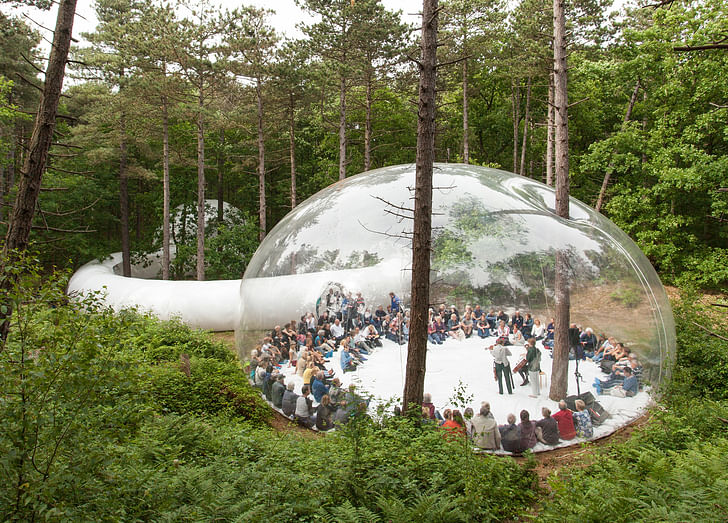
The culture and lifestyle associated with music festivals has greatly changed since they first emerged. Evolving from a symbol of counterculture into popular mainstream entertainment, many music festivals have embraced the use of visual arts and architecture. Typically, this comes in the form of temporary structures and installations that provide visual stimuli, some shade, and often much-needed landmarks for locating lost friends. Even if confined by a tight budget and a short deadline, these temporary structures nevertheless represent exciting examples of efficient and engaging design.
Coachella—Every April, throngs descend into Indio in California’s Coachella Valley for the Coachella Valley Music and Arts Festival. Now in its 17th year, Coachella has become one of North America's biggest music happenings, and has also largely embraced participation of artists and architects, who, tasked with designing visually-entertaining and shading structures, produce notable temporary installations every year.
This 50-foot-tall, colorful tree-house cluster buoyed above Coachella’s landscape this year, providing an intriguing symbol, a plinth to rest on, and shadow to hide under. “The spaces below the creates an unattainable ring of buildings, since time immemorial, story-tellers, prophets, disciples, and common-folk have gathered to rest and exchange oral histories,” writes the artist, Olalekan Jeyifous.
The 52-foot tall structure is a 1:1 section model of a fictional apartment building. Grand and cartoonish, it exposes the interior of a stack of bubbles via an architectural cut. “Designed with the festival audience and hot climate in mind, The Tower of Twelve Stories casts a long shadow that serves as a canopy during the daytime,” writes Bureau Spectacular. “It is like a large stencil that sprays tiny humans into a shaped silhouette against the scorching sun. Or, a very large bounce board for photographers chasing music gods.”
Pulp Pavilion had a remarkable materiality and structure. The tree-like pillars were created by hand-weaving jute rope around a removable metal-and-wood truss. Anchored with a metal plate and connected with a plywood frame at the bottom, the installation was then given color and rigidness with paper pulp—inexpensive, abundant waste material. The latticed canopy offered 1,300 square feet of shady respite.
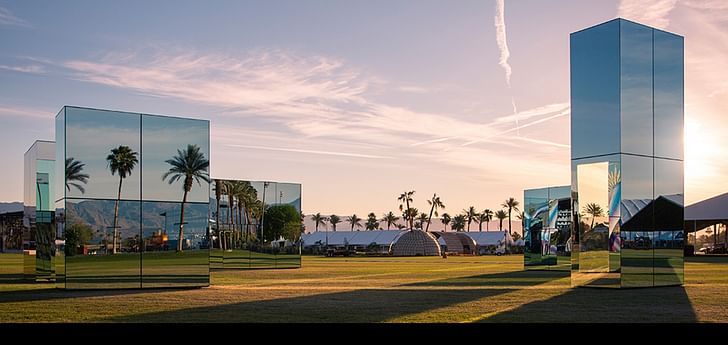
Reflection Field consisted of five large free-standing volumes, reflecting the surroundings with their mirror-clad and vividly luminescent surfaces. Spanning a diameter of 100 feet across the vast plain, the objects served as monolithic reflective masses during the day and expansive fields of color at night.
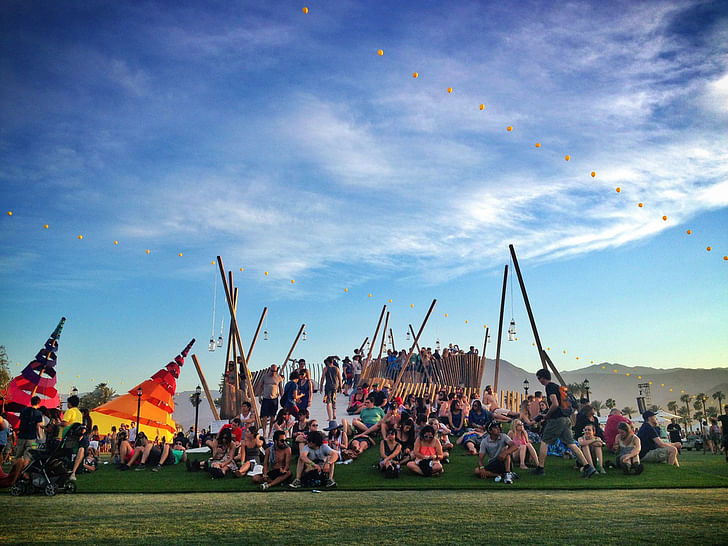
The grassy slope of the installation disrupted the flat, horizontal ground plane by creating conditions of high and low, above and below, near and far, flat and sloped, which otherwise could not be experienced. Twelve-feet high, it is a tunnel to explore, a place to rest on, and a semi-enclosed outdoor room.
Burning Man—A week-long festival of music and arts started by a group of artists and hippies in 1994, Burning Man annually gathers thousands of people in Nevada’s Black Rock Desert to construct a temporary city and a giant wooden effigy of a man. Leaving no trace behind—or so they say—but images of dusty participants and burned down structures, they always feature a great variety of crazy installations. Here’s a selection:

A luscious tree by day and a magical climbable light show by night, this installation was created by the Tree of Ténéré Team in collaboration with Studio DRIFT, manipulating light and movement to explore existing and new relationships between nature, technology and mankind. The 25,000 leaves of the structure are made up of 100,000 LED's—currently still on view at the Playa!

Built for the 2016 Burning Man, this golden cube invites people inside to “become a part of an art installation.” Renaixement mixes the contemporary language of the latticed architecture of the pavilion with the cardboard pieces and molds of a traditional elements from Valencia’s famous Fallas festival, where papier-maché and wood constructions are incinerated.
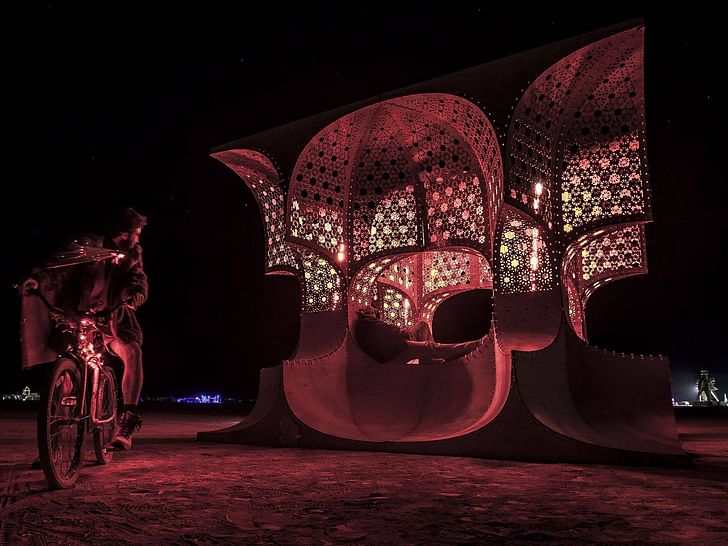
The perforated plywood structure, intended for contemplation, was a result of a year-long study of Moorish architecture and the refined geometry of the Alhambra and the Alcazars. Constructed out of perforated plywood, the curvilinear structure embodies the spirit of Islamic geometry.

Constructed out of around 1,000 off-the-shelf timber pieces, the climbable tower was digitally-designed to maximize inexpensive materials. Resembling a giant tree, the structure gently moved in the wind; its tangents, each stenciled with an inspiring quote, rotating along a central axis. “A simple curve, the brush of the artist, the beginning of many dreams, our tangential dreams,” the artists write. “This piece seeks to express the myriad of interpretations that we make of art and celebrates the dreams they engender.”
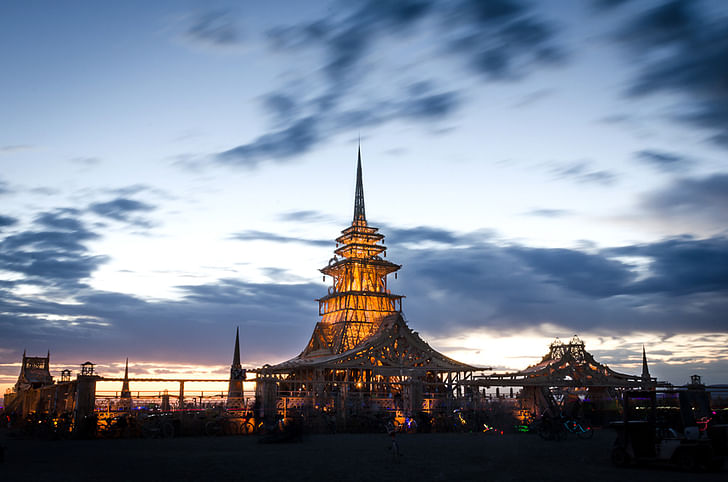
Temple Crew has been designing grand and mysterious sacred spaces for Burning Man since 2000. This one, constructed, as usual, out of reclaimed waste wood, sat within a 200'x200' walled courtyard accessible by four entrances. The temple's large enclosed exterior space, along with its interior structure and altar space, were clad with intricately cut wooden panels and were intended to serve as spaces for reflection and meditation.
Roskilde Music Festival—Held annually in Roskilde, Denmark, it is the largest music festival in Northern Europe. Similarly to other large festivals, it has been integrating more art installations into the program. This year the festival organizers are even devoting 6,400 meters to “Art Zone,” which will accommodate thematic installations.
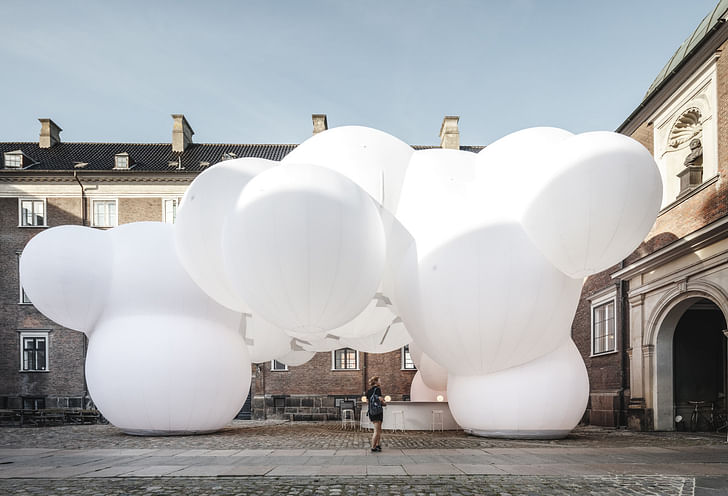
Drawing inspiration from childhood inflatable castles, the 120-square meter space designed by BIG was meant for festival guests to relax in between sets. The cloud-like inflatable installation was lit up by LED lights and only took 7 minutes to inflate. "The process of inflating and deflating the castle is easy. Producing it turned out to be much more difficult though than we had initially expected," said Jakob Lange, a partner at BIG's Copenhagen office.

One united structure consisting of 7 plywood shells—“The Ring,” “The Stage,” “The Ridge,” “The Reactor,” “The Barn,” “The Dressing Room,” and “The Courtyard”— the installation covered an area of 800 square meters. Its unusual format, developed in direct collaboration with performance artists, explored the idea of a “sensuous society.”

Inspired by Buckminster Fuller’s work, the method of this installation’s construction is fast, efficient, and low-cost. Made out of plywood, this geodesic dome installation optimized the use of resources to a high degree by imitating the molecular structure of carbon.

Open and flexible, the structure consists of two large stairs, offering seating and fun-looking “activity boxes” accommodating all sorts of activities throughout the festival’s duration. Constructed from re-used plywood, the space became a natural gathering spot, with its different orientations allowing for views of the main stage, the camp site, and the festival itself, in general.
Oerol Festival—Taking place in Terschelling, The Netherlands in June each year, Oerol is a unique event that, for ten days, serves as a stage for theater, dance, art, and music. Its unusual format embraces all kinds of locations—from the beaches, to the woods, or simply the street. The shows are created or adapted specially for the exceptional locations. Here’s a look at some of their innovative installations:
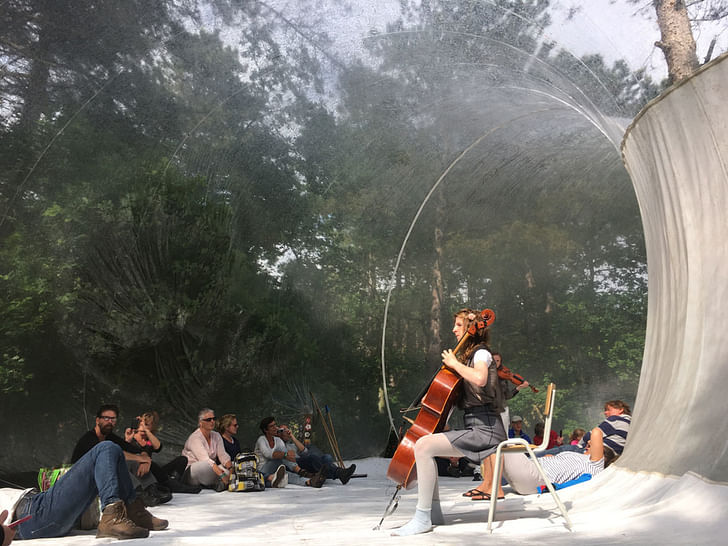
The 3-piece inflatable structure is a part of a composition made by artists coming from different backgrounds: dance, music, and architecture. The pneumatic architecture of Plastique Fantastique is monumental, yet mobile, soft, and transparent.
“Its ephemeral skin influences the environment as much as its inner space offers a lucid view outwards,” write the artists. “It is the preferred place to merge dance and music, and challenge the perception of time.”

Born out of a fascination with solstice gatherings, this land art object floated on the tide at the Noordsvaarder, occupying the landscape out as far as the horizon. The installation revealed a different aspect of the landscape with each passing hour and day.
Sziget Festival—Sziget Festival is a week-long music fest held on Budapest’s Old Buda Island every August and offering a wide variety of musical genres. While music is definitely the focus, over the last couple of years the organizers have also involved a variety of artists who have created some memorable installations.
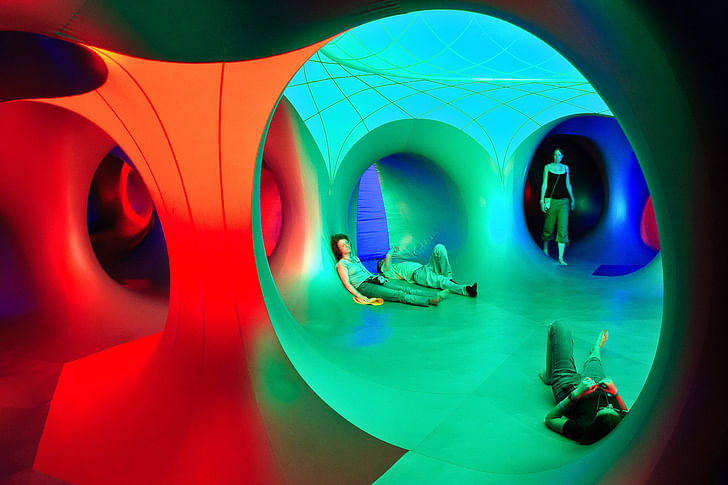
Luminarium is an inflatable light sculpture built by the UK-based Architects of Air. Constructed of custom-made colored PVC, it comprises approximately 10,000 meters of seams, 20,000 meters of masking tape, 5,000 square meters of plastic, and 200 liters of glue. The color effects are produced solely by sunlight passing through the colored panels of the structure and bouncing off the silver surfaces.
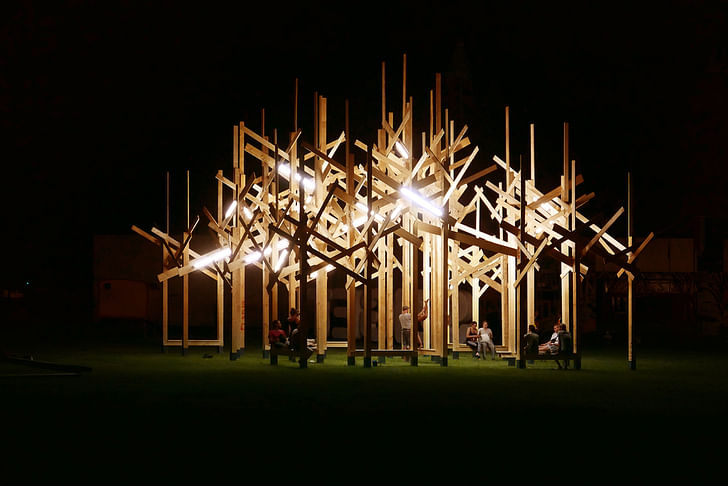
On a square grid a network of poles is randomly dispatched to create a seemingly wild ensemble imitating a forest, with various densities and transparencies depending on the viewpoint. The ‘trees’ are fastened to each other by branches, providing slight shade during the day and warm ambience at night.

Mirage pavilion consists of diamond-shaped mirrors that are arranged in a regular pattern, producing an effect of playful invisibility. Suspended at eye-level, 1,200 pieces of reflective plastic form a 23-meter-long wall woven among the trees, blending with the surrounding forest.
Arroyo Seco Weekend—Arroyo Seco is a two-day Pasadena-based music festival that was launched just last weekend. While it is much smaller, more relaxed and family friendly than its sister event, Coachella (organized also by Goldenvoice), it has set a similarly high bar for art installations. On Saturday, Archinect got to host a podcast on temporary architecture in one of them:

Made up of geometric masses, this open white structure provided both a breezy, shaded environment and an intimate area for the exchange of ideas. Surrounded by plants, and with snuggly pillows scattered all over, the structure became the most photogenic destination of the event.
Designed by one of our podcast guests, Peter Tolkin, this installation, which was illuminated at night with LED lights, served as a playful interactive landmark. Lightweight, inexpensive, and easily deployable, each of the three 22-foot diameter icosahedrons was formed with thirty pneumatic dunnage bags.
A designer & writer based in Los Angeles anastasiatokmakova.comyouthartsclub.com
5 Comments
Spectacular pieces of art, nice patterns and pieces!
fiction is to try to make real but some thinking is just
Not ever going to be real
What is the difference .
Why do architects design fictional worlds?
Studio Drift was a contributor to the project, but to say that it ‘created’ it is just not true. I have always had great respect Archinect, but please get your facts straight on this one. https://www.treeoftenere.com/team/
check this amazing festival out, its coming soon :) https://paaf.aab-edu.net/
эти временные конструкции действительно впечатляют. потрясающая статья. автору спасибо за помощь в исследовательской работе на эту тему
Block this user
Are you sure you want to block this user and hide all related comments throughout the site?
Archinect
This is your first comment on Archinect. Your comment will be visible once approved.